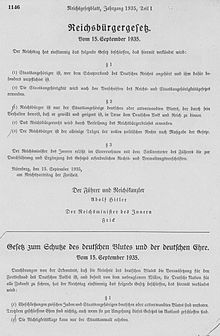
Back راسينشانده Arabic Rassenschande German Rassenschande Spanish بیحرمتی نژادی Persian Rassenschande French ראסנשאנדה HE Rassenschande ID Rassenschande Italian Rassenschande Dutch Raseskjending NB
| Rassenschande | |
|---|---|
| Racial shame | |
 Reich Citizenship Law (Reichsbürgergesetz) for the Protection of German Blood and German Honor, adopted unanimously by the Reichstag on 15 September 1935 |
Rassenschande (German: [ˈʁasn̩ˌʃandə], lit. "racial shame") or Blutschande (German: [ˈbluːtˌʃandə] ⓘ "blood disgrace") was an anti-miscegenation concept in Nazi German racial policy, pertaining to sexual relations between Aryans and non-Aryans. It was put into practice by policies like the Aryan certificate requirement,[1] and later by anti-miscegenation laws such as the Nuremberg Laws, adopted unanimously by the Reichstag on 15 September 1935. Initially, these laws referred predominantly to relations between ethnic Germans (classified, together with most other western Europeans, as "Aryans") and non-Aryans, regardless of citizenship. In the early stages the culprits were targeted informally; later, they were punished systematically and legally.
In the course of the ensuing war years, sexual relations between Reichsdeutschen (ethnic Germans, regardless of place of birth) and millions of foreign Ostarbeitern ("workers from the East") forcibly brought to Germany were also legally forbidden. Concerted efforts were made to foment popular distaste for it.[2][3] These laws were justified by Nazi racial ideology, which depicted Slavic people as Untermenschen. In addition, there was a practical reason behind the laws: prior to their enactment, Polish and Soviet women and girls working on German farms began having so many unwanted births that hundreds of special homes known as Ausländerkinder-Pflegestätte ("foster homes for foreign children") had to be created, in order to abort or kill the infants away from public view.[4][5][6]
- ^ Leila J. Rupp, Mobilizing Women for War, p 125, ISBN 0-691-04649-2
- ^ Ulrich Herbert (1997). Hitler's Foreign Workers: Enforced Foreign Labor in Germany Under the Third Reich. Cambridge University Press. ISBN 978-0-521-47000-1.
- ^ Majer, "Non-Germans" Under the Third Reich, p.180
- ^ Magdalena Sierocińska (2016). "Eksterminacja "niewartościowych rasowo" dzieci polskich robotnic przymusowych na terenie III Rzeszy w świetle postępowań prowadzonych przez Oddziałową Komisję Ścigania Zbrodni przeciwko Narodowi Polskiemu w Poznaniu" [Extermination of "racially worthless" children of enslaved Polish women in the territory of Nazi Germany from the IPN documents in Poznań]. Bibliography: R. Hrabar, N. Szuman; Cz. Łuczak; W. Rusiński. Warsaw, Poland: Institute of National Remembrance. Archived from the original on 2017-06-30. Retrieved 2016-02-22.
- ^ Lynn H. Nicholas (2009). "Arbeit Macht Frei: Forced Labour". Cruel World: The Children of Europe in the Nazi Web. Knopf Doubleday Publishing. p. 401. ISBN 978-0-679-77663-5.
- ^ Projekt "Krieg Gegen Kinder" (2004). "War Against Children". Database with information on over 400 confinement institutions in Nazi Germany for the children of Zwangsarbeiters (in German). Archived from the original on September 13, 2008 – via Internet Archive.